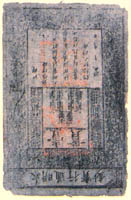| 1252 |
Florence, Italy was the first city to mint its own gold coins in 1252. The fiorino became known as the florence,
then the florin |
| 1940 |
Silver coins fell from the skies on to the town of Gorky, Russia. A tornado had lifted up an old money chest
and dropped the coins it contained as the wind carried it long |
| 1989 |
The Bank of Canada issued the last $1 bill. The paper buck's departure was preceded in 1987 by the arrival of
the dollar coin, affectionately known as the loonie |
| cleopatra |
cleopatra was no older than 18 when she became the queen of Egypt. Despite her glamorous image today, she is
depicted on ancient coins with a long hooked nose and masculine features |
| Beaver pelts |
The Canadian beaver was that country's first natural resource to be exploited by the Europeans. For many years
beaver pelts were a unit of currency |
| Eggs |
For a time, it was the custom to use eggs as a form of currency in France. Once a year, poverty-stricken clerics
and students trudged through the streets of Paris, carrying an egg basket, and collected what they could |
| Drums |
Kettle drums were once used as currency on the island of Aler in Indonesia |
| coin-throwing Marathon |
On July 2-3, 1999, a team of 30 people from the Sports Club Association Viialan Pyry, Finland, scored 92,551
points in 24 hours playing the traditional Finnish game of throwing coins at a flat target |
| 1962 |
The first international convention for coin collectors was held in August 15 - 18, 1962, in Detroit,
Michigan, sponsored by the American Numismatic Association and the Canadian Numismatic Association.
Attendance was estimated at 40,000 |
| Numismatics |
The scientific study of coins is known as "numismatics", a title derived from the Greek word nomisma,
meaning a coin or a currency. A numismatist may be a coin collector or not. A coin collector may be a
numismatist or not |
| Large and small |
The largest banknote in the world was issued in China during the Ming Dynasty (1368-1399). It was a 1
Juan with a size of 22.8 x 33 cm. The smallest banknote ever was issued in Romania in 1917. It was a 10
bani with a size of 2.28 x 3.8 cm.


|
| Japanese Currency Law |
According to the Japanese Currency Law, a maximum of 20 coins of the same denomination can be used as
legal tender. Rejection of the acceptance under 20 pieces of the same denomination is prohibited.
In case of over 20 pieces you can reject accepting the coins in daily transactions
|
| Coins Don't Smell, You Do |
Scientists have sniffed out the reason for the musty, "metallic" odor you smell after handling coins or
touching metal objects. A new study finds that the smell of iron is, ironically, a type of human body odor,
created by the breakdown of oils in skin after touching objects that contain the element. When touching
objects made of iron, perspiration from skin causes the iron atoms to gain two electrons. The doubly
negative iron atoms react with oil in skin, causing them to decompose, forming 1-octen-2-one |
| The largest numismatic organization |
The American Numismatic Association was founded in 1891 and chartered by the Congress of the United
States in 1912. The group has the world's largest circulating library of numismatic material and its
headquarters includes the World Money Museum, one of the top three numismatic museums in America |